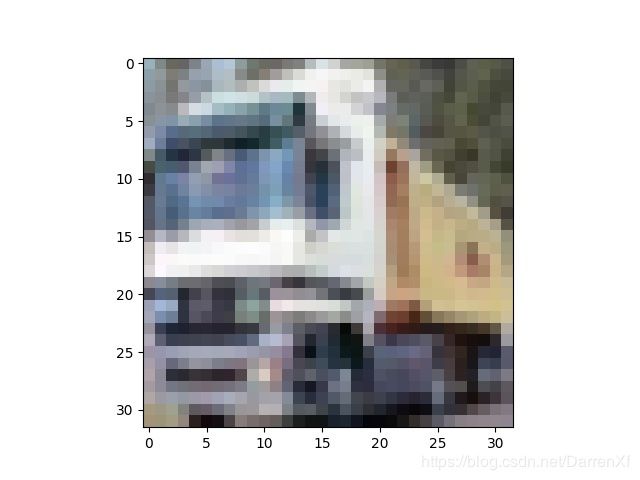cifar10数据格式以及读取方式
cifar10 数据网站
http://www.cs.toronto.edu/~kriz/cifar.html
读取下面的文件
CIFAR-10 binary version (suitable for C programs) 162 MB c32a1d4ab5d03f1284b67883e8d87530
下载cifar-10-binary.tar.gz 到./data/文件夹下
cd ./data/
解压下载后的文件到./data/
tar -xzvf cifar-10-binary.tar.gz
会出现一个文件夹 ‘cifar-10-batches-bin’
以及文件夹下的这些文件
batches.meta.txt
data_batch_1.bin
data_batch_2.bin
data_batch_3.bin
data_batch_4.bin
data_batch_5.bin
readme.html
test_batch.bin
data_batch_1.bin 到 data_batch_5.bin 是训练集二进制文件
每个文件中有10000张图片和10000个标记
共有50000张图片和50000个标记
每个二进制文件第一个字节是标记,后面的32x32x3是图片,
图片中前32x32 是 red channel, 接着32x32是 green channel,然后32x32 是blue channel. 然后依次类推.
依次类推.
test_batch.bin 是测试集文件
每个二进制文件是30730000个字节
下面是读取数据集的类文件
cifar10_dataset.py
#!/usr/bin/python
# -*- coding: utf-8 -*-
#####################################
# File name : cifar10_dataset.py
# Create date : 2018-12-24 19:58
# Modified date : 2018-12-31 16:21
# Author : DARREN
# Describe : not set
# Email : [email protected]
#####################################
from __future__ import division
from __future__ import print_function
#http://www.cs.toronto.edu/~kriz/cifar.html
import sys
import os
import struct
import numpy as np
import matplotlib.pyplot as plt
# pylint: disable=bad-continuation
meta_lt = [
"airplane",
"automobile",
"bird",
"cat",
"deer",
"dog",
"frog",
"horse",
"ship",
"truck",
]
# pylint: enable=bad-continuation
def create_path(path):
if not os.path.isdir(path):
os.makedirs(path)
def open_file_with_full_name(full_path, open_type):
try:
file_object = open(full_path, open_type)
return file_object
except Exception as e:
print(e)
return None
def get_file_full_name(path, name):
if path[-1] == "/":
full_name = path + name
else:
full_name = path + "/" + name
return full_name
def open_file(path, name, open_type='a'):
file_name = get_file_full_name(path, name)
return open_file_with_full_name(file_name, open_type)
def _get_file_header_data(file_obj, header_len, unpack_str):
raw_header = file_obj.read(header_len)
header_data = struct.unpack(unpack_str, raw_header)
return header_data
def _read_a_image(file_object):
raw_img = file_object.read(32 * 32)
red_img = struct.unpack(">1024B", raw_img)
raw_img = file_object.read(32 * 32)
green_img = struct.unpack(">1024B", raw_img)
raw_img = file_object.read(32 * 32)
blue_img = struct.unpack(">1024B", raw_img)
img = np.zeros(shape=(1024, 3))
for i in range(1024):
l = [red_img[i], green_img[i], blue_img[i]]
img[i] = l
img = img.reshape(32, 32, 3)
img = img / 255.
return img
def _read_one_image(file_object):
raw_img = file_object.read(32 * 32 * 3)
img = struct.unpack(">3072B", raw_img)
return img
def _read_a_label(file_object):
raw_label = file_object.read(1)
label = struct.unpack(">B", raw_label)
return label
def _get_image_full_name(path, label, count):
meta = meta_lt[label[0]]
full_path = "%s%s" %(path, meta)
create_path(full_path)
full_path_name = "%s/%s.jpg" %(full_path, count)
return full_path_name
def save_image(image, full_path_name):
plt.imshow(image)
plt.savefig(full_path_name)
plt.close()
class Cifar10Set(object):
def __init__(self, file_path):
super(Cifar10Set, self).__init__()
# pylint: disable=bad-continuation
self._train_file_list = [
"data_batch_1.bin",
"data_batch_2.bin",
"data_batch_3.bin",
"data_batch_4.bin",
"data_batch_5.bin"
]
# pylint: enable=bad-continuation
self._test_file_list = ["test_batch.bin",]
self.file_path = file_path
def _read_file(self, file_name):
file_object = open_file(self.file_path, file_name, open_type="rb")
return file_object
def _generate_a_batch(self, batch_size, file_list):
images = np.zeros(shape=(batch_size, 32 * 32 * 3))
labels = np.zeros(shape=(batch_size, 10))
i = 0
file_name = file_list[i]
file_name = "cifar-10-batches-bin/%s" % file_name
train_file = self._read_file(file_name)
count = 0
ret = True
while True:
while count < batch_size:
try:
label = _read_a_label(train_file)
image = _read_one_image(train_file)
images[count] = image
labels[count][label[0]] = 1
count += 1
except Exception as err:
#print(err)
if i >= len(self._train_file_list):
ret = False
break
else:
i += 1
if i < len(file_list):
file_name = file_list[i]
file_name = "cifar-10-batches-bin/%s" % file_name
train_file = self._read_file(file_name)
count = 0
yield images, labels.astype(int), ret
images = np.zeros(shape=(batch_size, 32*32*3))
labels = np.zeros(shape=(batch_size, 10))
def generator_images(self, file_list, path):
count = 1
for i in range(len(file_list)):
file_name = file_list[i]
file_name = "cifar-10-batches-bin/%s" % file_name
train_file = self._read_file(file_name)
while True:
try:
label = _read_a_label(train_file)
image = _read_a_image(train_file)
full_path_name = _get_image_full_name(path, label, count)
save_image(image, full_path_name)
print("file:%s count:%s"% (file_name, count))
except Exception as err:
print(err)
break
count += 1
def generator_train_images(self, path):
self.generator_images(self._train_file_list, path)
def generator_test_images(self, path):
self.generator_images(self._test_file_list, path)
def get_train_data_generator(self, batch_size=128):
file_list = self._train_file_list
gennerator = self._generate_a_batch(batch_size, file_list)
return gennerator
def get_test_data_generator(self, batch_size=128):
file_list = self._test_file_list
gennerator = self._generate_a_batch(batch_size, file_list)
return gennerator
def get_a_batch_data(self, data_generator):
if sys.version > '3':
batch_img, batch_labels, status = data_generator.__next__()
else:
batch_img, batch_labels, status = data_generator.next()
return batch_img, batch_labels, status
下面是main.py
#!/usr/bin/python
# -*- coding: utf-8 -*-
#####################################
# File name : main.py
# Create date : 2018-12-23 16:53
# Modified date : 2018-12-31 15:37
# Author : DARREN
# Describe : not set
# Email : [email protected]
#####################################
from __future__ import division
from __future__ import print_function
import cifar10_dataset
def test_cifar10_train_set():
file_path = "./data/"
batch_size = 100
dataset = cifar10_dataset.Cifar10Set(file_path)
data_generator = dataset.get_train_data_generator(batch_size)
count = 1
while True:
batch_img, batch_labels, status = dataset.get_a_batch_data(data_generator)
print("count:%s status:%s " % (count, status))
if not status:
break
count += 1
print(str(batch_labels))
def test_cifar10_test_set():
file_path = "./data/"
batch_size = 100
dataset = cifar10_dataset.Cifar10Set(file_path)
data_generator = dataset.get_test_data_generator(batch_size)
count = 1
while True:
batch_img, batch_labels, status = dataset.get_a_batch_data(data_generator)
print("count:%s status:%s " % (count, status))
if not status:
break
count += 1
print(str(batch_labels))
def test_generator_images():
test_generator_train_images()
test_generator_test_images()
def test_generator_train_images():
file_path = "./data/"
train_img_path = "./img/train/"
dataset = cifar10_dataset.Cifar10Set(file_path)
dataset.generator_train_images(train_img_path)
def test_generator_test_images():
file_path = "./data/"
test_img_path = "./img/test/"
dataset = cifar10_dataset.Cifar10Set(file_path)
dataset.generator_test_images(test_img_path)
def run():
test_cifar10_train_set()
test_cifar10_test_set()
test_generator_images()
run()
上面的代码可以在python2 以及python3 运行.可以批量读取cifar10的所有训练以及测试数据.
而且通过matplotlib 把二进制的数据转换保存成了图片.使我们可以看到这些图片真实的样子.
下面是一些保存的图片.
第一张图片是青蛙 ,放成这么大的话,我作为人表示还是这比较难看出来的.但是离远点看,或者缩小了后,就有点像青蛙了.









